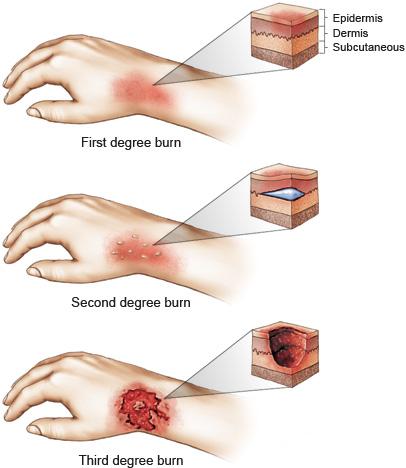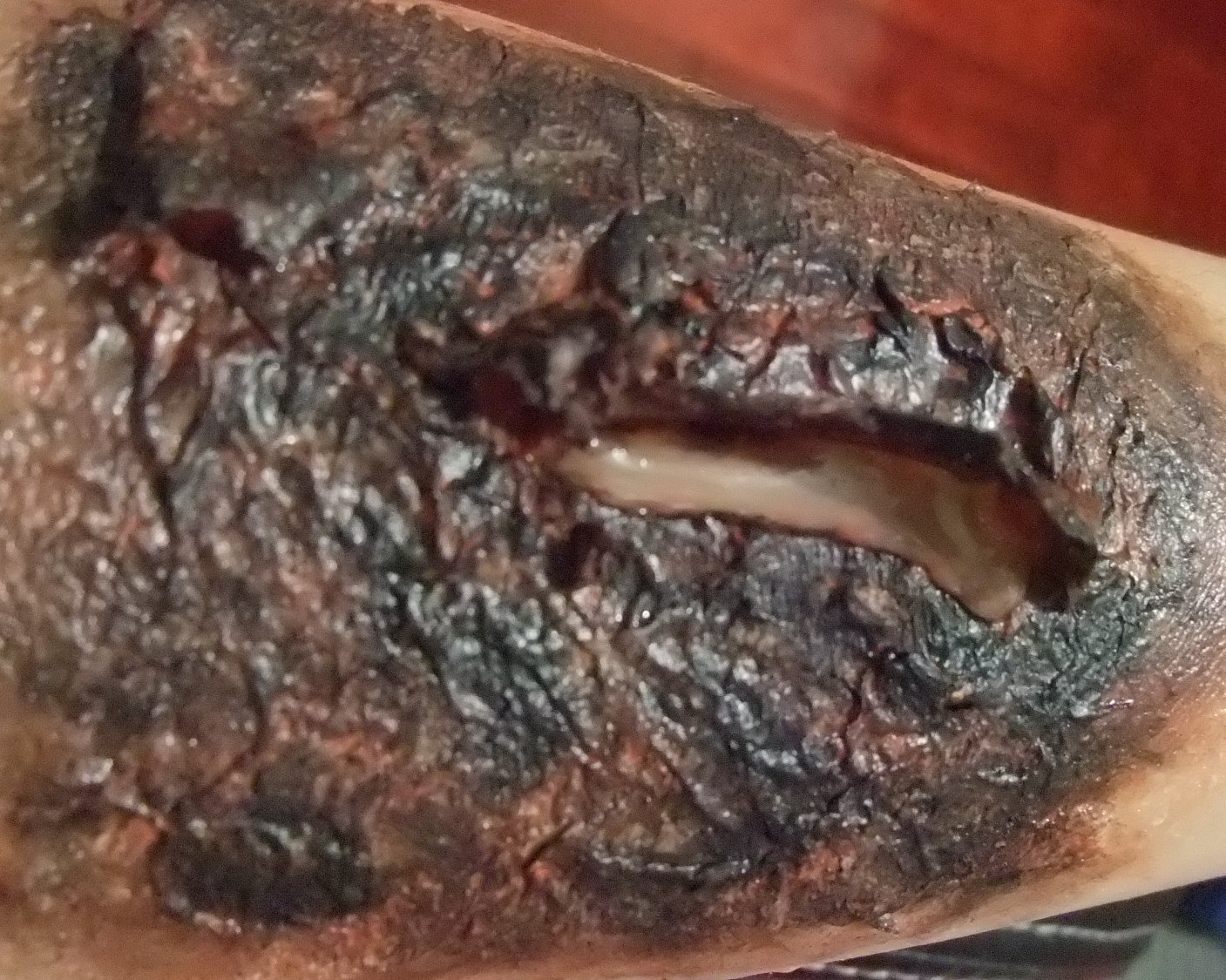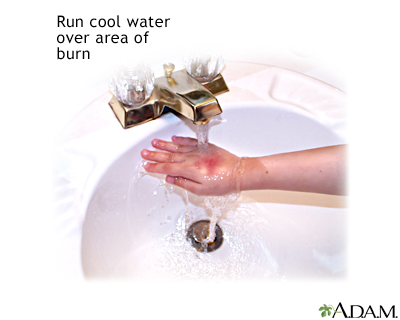

First of all, let's talk about the things you shouldn't do in the case of a burn:
- Do not apply ointment, butter, ice, medications, fluffy cotton, adhesive bandages, cream or oil spray. These can interfere with the healing process.
- Do not allow the burn to become contaminated. Avoid coughing or breathing on the burn.
- Do not touch or peel blistered and dead skin.
- Do not give the victim anything to ingest if he/she has a severe burn.
- Do not immerse a severe burn in cold water or apply cold compresses. This can cause shock.
- Do not place a pillow under a victim’s head if he/she has an airway burn because the airway could close, blocking the flow of air into the lungs.

Call emergency assistance immediately or transport the person to the nearest hospital if:
- The victim has a severe or extensive burn
- The victim has a chemical or electrical burn
- The victim shows signs of shock(confusion, rapid breathing, sweaty but cool skin,paleness of the skin, restlessness and nervousness etc) are present
- Airway burn has occurred
NEXT THING IS TO DETERMINE THE DEGREE OF BURN
This will help you determine the severity and thus, help you determine your next course of action.

1
Tell if it is a first degree burn. First degree burns are the most common, and happen as a result of light scalding, brief contact with hot items, and the sun. They will likely appear red, slightly swollen, and may or may not be slightly painful. First degree burns affect only the outermost layer, the first layer, of your skin.- First degree burns are classified as ‘minor burns’ and should be treated as such.
- Sometimes you may receive an extensive first degree burn - such as a full body sunburn - but this does not need medical attention. Treat your first degree burn at home.


2
Second degree burns. These carry the characteristics of first degree burns - redness, swelling, and pain - but additionally the skin may appear blotchy, blisters will form, and the pain will be much more intense. These can occur from brief contact with incredibly hot things (boiling water, for example), extended contact with hot items, and prolonged exposure time in the sun. A second degree burn is called such because it burns through two layers of your skin.- Unless your second degree burn is located on your hands, feet, groin, or face, it should be treated as a minor burn.
- If your second degree burn is wider than three inches, you should call your doctor for medical help.



3
Third degree burn. Third degree burns are the most serious of the three classifications and require immediate medical attention. These occur when extended exposure to a very hot object burns through all three layers of your skin, sometimes causing muscle, fat, and bone damage. They will look leathery and have a white or black appearance on the skin.- Third degree burns are always classified as a major burn and require treatment from a doctor as soon as possible. It is an emergency!



TREATMENT
For minor burns (1ST DEGREE BURNS)
1. Use cool water. Stick the burned area under cool running water for 10-15 minutes; if you can still feel the burning sensation, then your skin is still being burned. Avoid using very cold water, as this can damage the skin around the burn.

2. Add a cold compress. If cold water isn't an option, use a cold compress or ice pack wrapped in a towel and placed over your burn. Never apply ice or your compress directly to the burn, as this will damage the skin.

3.Take a pain reliever. Use an over-the-counter pain reliever such as ibuprofen, acetaminophen, aspirin, or naproxen. If the pain and swelling does not dissipate after several hours, take another dose of the medication. Avoid giving aspirin to young children or if you are recently recovering from the flu or chickenpox.

4. Apply egg oil (egg yolk oil) twice a day for a week or until the burn wound is completely healed. Egg oil treatment showed abundant re-epithelialization on second or third degree burns without tissue scar. Egg oil has many vital nutrients including essential Omega-3 fatty acids like Docosahexaenoic Acid, anti-oxidants like lutein & zeaxanthin and immunoglobulins.

5.Use aloe vera. Aloe vera is a type of plant that excretes a clear gel used to treat burns. Use the gel directly from a live plant or find a processed gel from a local drugstore. Apply in a thin layer (it won't rub in) to the area of the burn.

6. Apply a little honey. Honey works to kill bacteria that might be in the burn and draws moisture from your skin, which helps to soothe the burnt area. Spread a thin layer of honey over your burn or dab some on gauze before wrapping the area.

FOR MAJOR BURNS ( 2ND AND 3RD DEGREE BURNS)
1. Call for an ambulance or visit your doctor or an emergency room immediately.
2.Don't remove any clothing. Although there may be fabric from clothing covering your burn, do not attempt to pull it off or adjust it. Removing clothing from burned areas is likely to cause bleeding. However, if not stuck to the burn, you should remove jewelry and unburned clothing as it may constrict the burned area.
3.Remove jewelry, belts and other restrictive items,especially from around burned areas and the neck. Burned areas swell rapidly.
4.Elevate the burned area. Raise the wound above heart level, if possible.
4.Elevate the burned area. Raise the wound above heart level, if possible.
SOURCE: Mayoclinic.org
wikihow.com
surgery.med.miami.edu
point no.5 of what you shouldn't do incase of a burn, contradicts treatment points no.2 for 1st degree burn and point no.3 for 2nd and 3rd degree burn
ReplyDeleteThanks for your comment.
DeletePoint no. 5 for what you shouldn't do in case of a burn states:
Do not IMMERSE A SEVERE BURN in cold water or apply cold compresses. This can cause shock.
1st degree burn is not a severe burn and is definitely not going to cause shock because fluid loss is minimal and a cold compress is not going to lead to drastic temperature change.
As for treatment points no.2 for 2nd and 3rd degree burn i will correct it. Thank you for your observation!
Great article!!! Very informative & interesting!!!
ReplyDelete